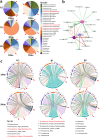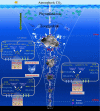Illuminating Key Microbial Players and Metabolic Processes Involved in the Remineralization of Particulate Organic Carbon in the Ocean's Twilight Zone by Metaproteomics
- PMID: 34319792
- PMCID: PMC8478463
- DOI: 10.1128/AEM.00986-21
Illuminating Key Microbial Players and Metabolic Processes Involved in the Remineralization of Particulate Organic Carbon in the Ocean's Twilight Zone by Metaproteomics
Abstract
The twilight zone (from the base of the euphotic zone to the depth of 1,000 m) is the major area of particulate organic carbon (POC) remineralization in the ocean, and heterotrophic microbes contribute to more than 70% of the estimated remineralization. However, little is known about the microbial community and metabolic activity directly associated with POC remineralization in this chronically understudied realm. Here, we characterized the microbial community proteomes of POC samples collected from the twilight zone of three contrasting sites in the Northwest Pacific Ocean using a metaproteomic approach. The particle-attached bacteria from Alteromonadales, Rhodobacterales, and Enterobacterales were the primary POC remineralizers. Hydrolytic enzymes, including proteases and hydrolases, that degrade proteinaceous components and polysaccharides, the main constituents of POC, were abundant and taxonomically associated with these bacterial groups. Furthermore, identification of diverse species-specific transporters and metabolic enzymes implied niche specialization for nutrient acquisition among these bacterial groups. Temperature was the main environmental factor driving the active bacterial groups and metabolic processes, and Enterobacterales replaced Alteromonadales as the predominant group under low temperature. This study provides insight into the key bacteria and metabolic processes involved in POC remineralization, and niche complementarity and species substitution among bacterial groups are critical for efficient POC remineralization in the twilight zone. IMPORTANCE The ocean's twilight zone is a critical zone where more than 70% of the sinking particulate organic carbon (POC) is remineralized. Therefore, the twilight zone determines the size of biological carbon storage in the ocean and regulates the global climate. Prokaryotes are major players that govern remineralization of POC in this region. However, knowledge of microbial community structure and metabolic activity is still lacking. This study unveiled microbial communities and metabolic activities of POC samples collected from the twilight zone of three contrasting environments in the Northwest Pacific Ocean using a metaproteomic approach. Alteromonadales, Rhodobacterales, and Enterobacterales were the major remineralizers of POC. They excreted diverse species-specific hydrolytic enzymes to split POC into solubilized POC or dissolved organic carbon. Temperature played a crucial role in regulating the community composition and metabolism. Furthermore, niche complementarity or species substitution among bacterial groups guaranteed the efficient remineralization of POC in the twilight zone.
Keywords: metaproteomics; microbe; ocean twilight zone; particulate organic carbon; remineralization.
Figures





Similar articles
-
Community differences and potential function along the particle size spectrum of microbes in the twilight zone.Microbiome. 2025 May 14;13(1):121. doi: 10.1186/s40168-025-02116-8. Microbiome. 2025. PMID: 40369676 Free PMC article.
-
Metaproteomics Reveals Similar Vertical Distribution of Microbial Transport Proteins in Particulate Organic Matter Throughout the Water Column in the Northwest Pacific Ocean.Front Microbiol. 2021 Mar 25;12:629802. doi: 10.3389/fmicb.2021.629802. eCollection 2021. Front Microbiol. 2021. PMID: 33841356 Free PMC article.
-
Microbial iron limitation in the ocean's twilight zone.Nature. 2024 Sep;633(8031):823-827. doi: 10.1038/s41586-024-07905-z. Epub 2024 Sep 25. Nature. 2024. PMID: 39322731
-
Microbial production of recalcitrant dissolved organic matter: long-term carbon storage in the global ocean.Nat Rev Microbiol. 2010 Aug;8(8):593-9. doi: 10.1038/nrmicro2386. Epub 2010 Jul 5. Nat Rev Microbiol. 2010. PMID: 20601964 Review.
-
Particulate organic matter in the sea: the composition conundrum.Ambio. 2004 Dec;33(8):565-75. doi: 10.1579/0044-7447-33.8.565. Ambio. 2004. PMID: 15666690 Review.
Cited by
-
Functional vertical connectivity of microbial communities in the ocean.Sci Adv. 2024 May 24;10(21):eadj8184. doi: 10.1126/sciadv.adj8184. Epub 2024 May 23. Sci Adv. 2024. PMID: 38781332 Free PMC article.
-
Surface Bacterioplankton Community Structure Crossing the Antarctic Circumpolar Current Fronts.Microorganisms. 2023 Mar 9;11(3):702. doi: 10.3390/microorganisms11030702. Microorganisms. 2023. PMID: 36985275 Free PMC article.
-
The Vertical Metabolic Activity and Community Structure of Prokaryotes along Different Water Depths in the Kermadec and Diamantina Trenches.Microorganisms. 2024 Mar 30;12(4):708. doi: 10.3390/microorganisms12040708. Microorganisms. 2024. PMID: 38674652 Free PMC article.
-
Decoding drivers of carbon flux attenuation in the oceanic biological pump.Nature. 2024 Sep;633(8030):587-593. doi: 10.1038/s41586-024-07850-x. Epub 2024 Sep 11. Nature. 2024. PMID: 39261723 Free PMC article.
-
Metabolic activity and community structure of prokaryotes associated with particles in the twilight zone of the South China Sea.Front Microbiol. 2022 Dec 6;13:1056860. doi: 10.3389/fmicb.2022.1056860. eCollection 2022. Front Microbiol. 2022. PMID: 36560947 Free PMC article.
References
-
- Buesseler KO, Lamborg CH, Boyd PW, Lam PJ, Trull TW, Bidigare RR, Bishop JKB, Casciotti KL, Dehairs F, Elskens M, Honda M, Karl DM, Siegel DA, Silver MW, Steinberg DK, Valdes J, Van Mooy B, Wilson S. 2007. Revisiting carbon flux through the ocean's twilight zone. Science 316:567–570. 10.1126/science.1137959. - DOI - PubMed
-
- Mayor DJ, Sanders R, Giering SL, Anderson TR. 2014. Microbial gardening in the ocean's twilight zone: detritivorous metazoans benefit from fragmenting, rather than ingesting, sinking detritus: fragmentation of refractory detritus by zooplankton beneath the euphotic zone stimulates the harvestable production of labile and nutritious microbial biomass. Bioessays 36:1132–1137. 10.1002/bies.201400100. - DOI - PMC - PubMed
-
- Jiao N, Robinson C, Azam F, Thomas H, Baltar F, Dang H, Hardman-Mountford NJ, Johnson M, Kirchman DL, Koch BP, Legendre L, Li C, Liu J, Luo T, Luo YW, Mitra A, Romanou A, Tang K, Wang X, Zhang C, Zhang R. 2014. Mechanisms of microbial carbon sequestration in the ocean—future research directions. Biogeosciences 11:5285–5306. 10.5194/bg-11-5285-2014. - DOI
Publication types
MeSH terms
Substances
LinkOut - more resources
Full Text Sources

